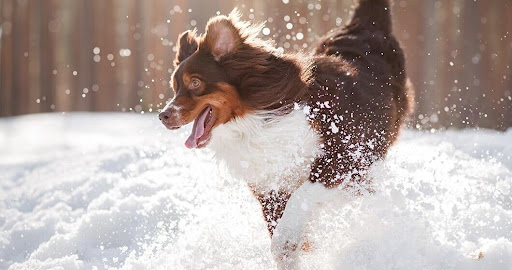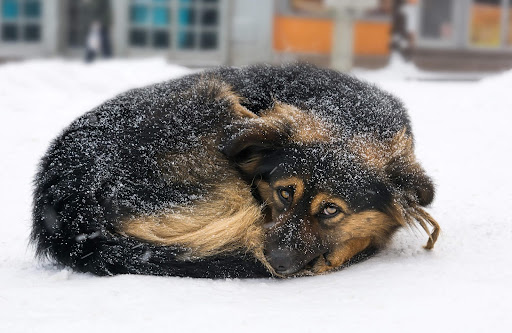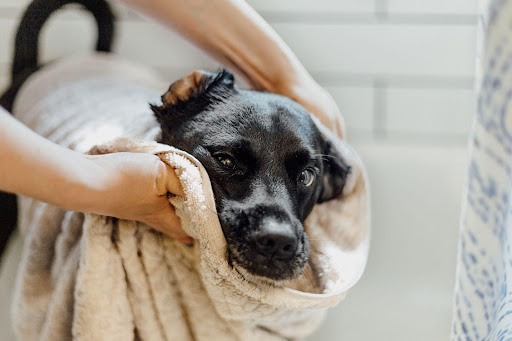
Most dogs love the snow. Maybe it’s the change in appearance of the landscape, the feel of a fluffy and cool new substance while rolling around, or could it be the scent or something new to dig in? Whatever it is – snow brings a new level of excitement most dogs simply can’t resist.
Depending on your pet’s activity level and tolerance for chilly weather, there are numerous fun winter activities to spice up playtime for your doggo. From hiking and sledding to skijoring and simply frolicking, almost every game you can think of will be more mentally and physically stimulating in the snow. The extra exercise is great for most dogs so take advantage of playing with your dog in the snow and boost your companionship
While some dogs will leap with reckless abandonment into a fresh snowpack, other dogs long for more temperate types of weather. Weather preference is mostly based on physical make up and where dogs were bred and live.
Canine Traits
Generally, dogs with natural long coats and undercoats of fur tend to endure the cold more easily. Meanwhile, short hair and hairless breeds are usually less tolerant of the chill. Breeds like huskies and malamutes have wide paw pads and their bodies are covered in snow-repelling fur, along with smaller ears for less exposure to frostbite. If you have any of the following breeds, cold weather likely won’t be a problem.
- The Alaskan Malamute is the oldest and largest of the Arctic sled dogs.
- The Keeshond has a very thick coat that kept it warm when it served as a watchdog on riverboats in Holland.
- The Newfoundland has a heavy coat that protected it from the icy waters it was originally bred to work in.
- An ancient breed from Scandinavia with Nordic traits, the Norwegian Elkhound is used to hunting in the cold climate it came from.
- Tibetan Mastiffs developed in the cold of the Himalayan Mountains and have an immense double coat that keeps them insulated.
- The Husky originated in the cold climate of Northeast Asia and was also bred to be a sled dog.
- The Saint Bernard comes from the Swiss Alps and was originally used to locate freezing and helpless travelers during snowstorms.
There are plenty of short-haired dogs that genuinely enjoy playing in the snow too, although they may not endure it for quite as long as their hairier counterparts. Smaller breeds with short legs and bare bellies might get cold fast and tire out as they wade or jump through deep snow. Puppies, elderly dogs, and dogs with arthritis or other health problems can also be more sensitive to cold and snowy conditions.
Whether your dog loves the snow and can seemingly play in it all day long or you have a dog who is a little more sensitive to the cold, all dog owners should be aware of the following signs that your dog might be uncomfortable due to the cold:
- Anxious behavior
- Shivering
- Lifts their paws up off the ground
- Hunched posture or a tucked tail
- Reluctance to go outdoors
- Whining, whimpering or barking
- Refuses to move/walk once outside
- Seeks out areas for shelter

In addition to the above signs, dog owners should be aware of the following winter safety tips as well:
-
- Thirty (30) minutes out in the snow is the general rule of thumb for most dogs according to PetCareRX
- Yes, dogs can get Frostbite. If your dog is outside for a prolonged period in freezing temperatures – particularly if they get wet – your dog can get frostbite, especially on an exposed belly, paws, or skin. Some signs of frostbite are cold skin that discolored with a bluish-white hue or joint stiffness and clumsiness.
- Dogs can get Hypothermia. When a dog’s body temperature drops below 102.5 degrees your dog is in danger. Signs of hypothermia include shivering, becoming quiet and curling up, cold appendages and whining.
- Protect your dog’s paws. While dog paw pads are more resilient than human feet, not all dog paws are equally calloused. Uncalloused paws are more vulnerable to the cold and can easily allow salt to penetrate and burn. Buying pet-friendly rock salt can help as can those cute little paw booties or high quality paw wax.
- While the cold and snow tends to kill off most pests, fleas and ticks like to seek warm shelter in winter so don’t give up on routine flea and tick inspections and medication just because you think all the bugs are dead.
- Spend a little extra time getting those bits of snow out, and your pup will be much happier. Your dog will probably try to remove these on their own, but that’s not necessarily safe. Excessive licking, chewing, and gnawing can damage skin that’s already dry due to the cold weather. Also, it’s possible that the snow on your dog’s fur can hide antifreeze or salt, which can make them very sick.

Love it or hate it, snow is part of winter here in the Northwest. Hopefully the above information will help you and your furry companion enjoy the snow. Another important thing to remember is dog waste does not dissolve in the snow. So, just because you may not see it, dogs still poo in the snow and it doesn’t go away. Call our scoopologist at Scoopology Pet Waste Removal 360-612-7667 and we will do the doody work for you when the snow melts. Be safe!

